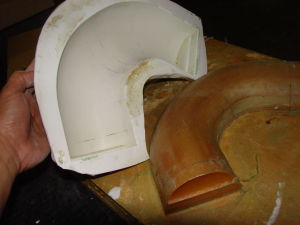MAX EMC A/B
A modeling and tooling compound with a clay, dough like consistency. Cures to a hard, smooth, ceramic-like finish.
Can be used for any void or gap filling applications without the strong odor and health hazard of polyester resin.

Or visit our eBay Store, PolymerProducts.
Available Kit Sizes:
DESCRIPTION
ROOM TEMPERATURE CURING BULK MOLD COMPOUND
MAX EMC A/B is an epoxy based molding and modeling resin system that offers a formable compound that cures to a hard and durable polymer.MAX EMC A/B holds its profile when sculpted or formed to shape. When cured, it demonstrates lightweight in density with a high compressive strength.It is also dimensionally stable, non-porous, sandable and can be machined and painted.MAX EMC is also an excellent SMC and BMC repair compound. Measure out equal parts of Part A and Part B and mix by kneading together by hand until a uniform color is achieved. A fist-size mass will have about 90 to 120 minutes of working time. A larger mass will have a shorter working time due to heat generation (Exotherm). Color tinting can be done at this stage by kneading the pigment paste or powder to the mix.Press in into any mold and allow to cure over night at room temperature and demold. MAX EMC cures to a tough but easily sandable compound suitable for molding, modeling, patching holes and gauges on composites panels, wood or metal hulls and SMC parts. It is also can be used as an adhesive for lightweight applications such as RC hobby craft, capable of bonding metals, composites, fiberglass and SMC (Sheet Molding Compound) parts.MAX EMC can be pigmented to any desired color by using our color dispersion. Please on the links below to view our Included with every kit is a copy of MSDS, DATA SHEET and our Comprehensive “Surface Preparation and Applications Bulletin” which contains a wealth of information high performance bonding technology.
Suitable for:
- Prototyping
- Filleting
- Gap filling
- Bonding
Physical and Mechanical Properties
| Plastic Processing Temperatures In Degrees F |
|||||||||
| Material | Specific Gravity | Mold Surface & Demolds | Lower Processing | Orientation | Upper Temp | ||||
| ABS | 1.07 | 185 | 260 | 280 | 400 | ||||
| Acrylic | 1.15 | 185 | 300 | 325 | 425 | ||||
| Acrylic/PVC | 1.15 | 175 | 290 | 310 | 400 | ||||
| Polycarbonate | 1.20 | 280 | 335 | 350 | 400 | ||||
| Polyethersulfone | 1.37 | 400 | 525 | 560 | 700 | ||||
| Polyethersulfone, glass filled 20% | 1.51 | 410 | 535 | 560 | 720 | ||||
| Polyethylene, high density | 0.99 | 180 | 260 | 270 | 430 | ||||
| Polypropylene | 0.92 | 257 | 270 | 280 | 380 | ||||
| Polypropylene, glass filled | 1.05 | 195 | 265 | 280 | 450 | ||||
| Polysulfone | 1.24 | 325 | 375 | 415 | 575 | ||||
| Polystyrene | 1.06 | 185 | 260 | 275 | 360 | ||||
| Vinyl, rigid | 1.47 | 150 | 220 | 245 | 310 | ||||
| Vinyl, rigid foam | 0.70 | 160 | 240 | 260 | 350 | ||||